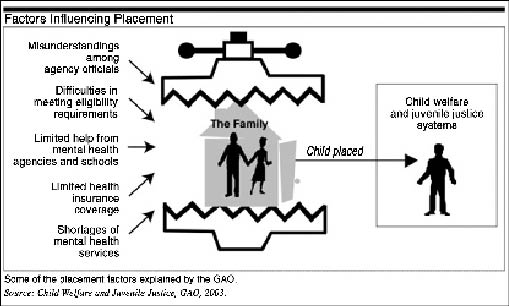 |
|
Click on graphic to enlarge. |
Nebraska may have solved the debacle last month over its Safe Haven law – under which at least 34 youths were abandoned by parents and guardians – but what remains is the scandal that the law illuminated: desperate families relinquishing custody of their children in order to get them mental health care through the juvenile justice and child welfare systems.
That, despite a swell in research, media coverage and calls to action that began in earnest in 2001 to address the very issue that Nebraska lawmakers unwittingly tapped into.
When they enacted the law in July, there were mild questions about whether the law was inviting trouble with its unique aspect: allowing people to safely relinquish youths up to age 18, rather than covering only infants, as do other state Safe Haven laws.
All of the children abandoned over the last five months were older than the infants the law sought to protect. Only one, a 1-year-old, was under age 5. The Nebraska Legislature met in a special session last month to rewrite the law; now parents can abandon only infants up to 30 days without fear of prosecution.
What’s striking are the parallels between the youths dropped off in Nebraska and the warnings that have been issued in recent years.
In April 2003, the U.S. Government Accountability Office (GAO) released a report, Child Welfare and Juvenile Justice: Federal Agencies Could Play a Stronger Role in Helping States Reduce the Number of Children Placed Solely to Obtain Mental Health Services (www.gao.gov/new.items/d03397.pdf). The study was based on a GAO survey of child welfare directors in 19 states and juvenile justice officials in 30 counties, which found that parents had placed more than 12,700 children into their systems in 2001 in order to get access to mental health services. The report said the real number was much higher, given that no agency tracks or maintains data on such children.
The state and local officials told GAO that most of the abandoned children were male adolescents with multiple problems. They found that the children came from families of all financial levels, and that “the seriousness of the child’s illness strained the family’s ability to function” by, for example, precluding parents from meeting the needs of other children in the family or fulfilling job-related responsibilities.
Compare that description to the demographics of youths dropped off under Nebraska’s Safe Haven law since July, as compiled by the state Department of Health and Human Services (DHHS):
• Twenty-eight of the 34 youths abandoned were age 10 or older.
• Eighteen of those 28 were male.
• Of all the abandoned children, 24 were eligible for Medicaid.
• All but four of the children lived with a single parent or guardian.
• All but four had received mental health services. But despite their Medicaid eligibility, only 11 had received mental health treatment at a level higher than outpatient services.
What’s Needed?
Parents seeking help from states will usually find those states unprepared to help directly, as explained by Todd A. Landry, director of Nebraska’s Division of Children and Family Services, in testimony last month before the state Legislature: “For children or youth who are otherwise safe, it is not the role of the state to intervene in a family’s life. Instead, available community services are the appropriate mechanism for families to access for assistance and help.”
But although DHHS recently updated its website and issued new public service announcements to steer people toward those community services, there is reason to believe that such superficial steps will do little good.
Child welfare, child mental health and juvenile justice officials told the GAO that parents relinquished custody of their troubled children because of health insurance limitations and restrictions on mental health services, a chronically short supply of child psychiatric and residential services, a lack of affordability or access to the services offered by mental health agencies and schools, and differing eligibility thresholds across family support agencies at the federal, state and local levels – not because they were unaware of available resources.
Nebraska appears to fit the norm. In October, Kathy Bigsby, executive director of Voices for Children in Nebraska, charged that state policymakers have “invested few dollars in prevention, basic family supports and early intervention services,” driving children “deeper into the foster care and juvenile justice systems in search of services and supports.”
She blamed lackluster funding of behavioral health services; the low income eligibility level for Kids Connection, the Nebraska children’s health insurance program (among the nine lowest state levels in the nation, at 185 percent of the federal poverty line); and the state’s propensity to incarcerate youths for nonviolent offenses (accounting for 81 percent of adjudicated youth, versus a national average of 66 percent) rather than to provide community-based alternatives.
What to do? In the 2003 GAO report, officials suggested “reduc[ing] the cost of or fund[ing] mental health services, improving access to mental health services, and expanding the array of available services.”
Carrying that out is complicated and potentially costly. Thanks to Nebraska, we have a feel for how little progress has been made on those fronts five years later.
Contact: Nebraska DHHS (402) 471-3121, http://www.dhhs.ne.gov/SafeHaven; Voices for Children in Nebraska, http://www.voicesforchildren.com.
























